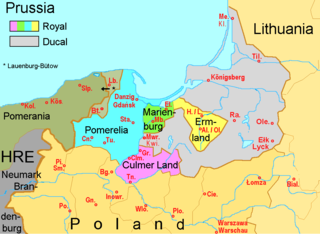
Czarne Małe is a village in the administrative district of Gmina Czaplinek, within Drawsko County, West Pomeranian Voivodeship, in north-western Poland. It lies approximately 7 kilometres (4 mi) east of Czaplinek, 36 km (22 mi) east of Drawsko Pomorskie, and 117 km (73 mi) east of the regional capital Szczecin.

Ostroróg is a village in the administrative district of Gmina Czaplinek, within Drawsko County, West Pomeranian Voivodeship, in north-western Poland. It lies approximately 12 kilometres (7 mi) east of Czaplinek, 40 km (25 mi) east of Drawsko Pomorskie, and 122 km (76 mi) east of the regional capital Szczecin.

Chwalimki is a village in the administrative district of Gmina Barwice, within Szczecinek County, West Pomeranian Voivodeship, in north-western Poland. It lies approximately 8 kilometres (5 mi) east of Barwice, 15 km (9 mi) west of Szczecinek, and 130 km (81 mi) east of the regional capital Szczecin.

Jeziorki is a village in the administrative district of Gmina Barwice, within Szczecinek County, West Pomeranian Voivodeship, in north-western Poland. It lies approximately 9 kilometres (6 mi) south-east of Barwice, 15 km (9 mi) west of Szczecinek, and 129 km (80 mi) east of the regional capital Szczecin.

Nowy Chwalim is a village in the administrative district of Gmina Barwice, within Szczecinek County, West Pomeranian Voivodeship, in north-western Poland.

Polne is a village in the administrative district of Gmina Barwice, within Szczecinek County, West Pomeranian Voivodeship, in north-western Poland. It lies approximately 10 kilometres (6 mi) south of Barwice, 26 km (16 mi) west of Szczecinek, and 118 km (73 mi) east of the regional capital Szczecin.

Sulikowo is a village in the administrative district of Gmina Barwice, within Szczecinek County, West Pomeranian Voivodeship, in north-western Poland. It lies approximately 8 kilometres (5 mi) north of Barwice, 25 km (16 mi) west of Szczecinek, and 124 km (77 mi) east of the regional capital Szczecin.

Jeleń is a village in the administrative district of Gmina Borne Sulinowo, within Szczecinek County, West Pomeranian Voivodeship, in north-western Poland. It lies approximately 6 kilometres (4 mi) north-east of Borne Sulinowo, 13 km (8 mi) south-west of Szczecinek, and 136 km (85 mi) east of the regional capital Szczecin.

Jeziorna is a village in the administrative district of Gmina Borne Sulinowo, within Szczecinek County, West Pomeranian Voivodeship, in north-western Poland. It lies approximately 8 kilometres (5 mi) south-west of Borne Sulinowo, 26 km (16 mi) south-west of Szczecinek, and 125 km (78 mi) east of the regional capital Szczecin.

Komorze is a village in the administrative district of Gmina Borne Sulinowo, within Szczecinek County, West Pomeranian Voivodeship, in north-western Poland. It lies approximately 14 kilometres (9 mi) north-west of Borne Sulinowo, 24 km (15 mi) south-west of Szczecinek, and 120 km (75 mi) east of the regional capital Szczecin.

Łubowo is a village in the administrative district of Gmina Borne Sulinowo, within Szczecinek County, West Pomeranian Voivodeship, in north-western Poland. It lies approximately 10 kilometres (6 mi) west of Borne Sulinowo, 25 km (16 mi) south-west of Szczecinek, and 121 km (75 mi) east of the regional capital Szczecin.

Nobliny is a village in the administrative district of Gmina Borne Sulinowo, within Szczecinek County, West Pomeranian Voivodeship, in north-western Poland. It lies approximately 9 kilometres (6 mi) west of Borne Sulinowo, 26 km (16 mi) south-west of Szczecinek, and 122 km (76 mi) east of the regional capital Szczecin.

Przeradz is a village in the administrative district of Gmina Grzmiąca, within Szczecinek County, West Pomeranian Voivodeship, in north-western Poland. It lies approximately 13 kilometres (8 mi) south-east of Grzmiąca, 11 km (7 mi) north-west of Szczecinek, and 136 km (85 mi) east of the regional capital Szczecin.

Storkowo is a village in the administrative district of Gmina Grzmiąca, within Szczecinek County, West Pomeranian Voivodeship, in north-western Poland. It lies approximately 6 kilometres (4 mi) south-east of Grzmiąca, 17 km (11 mi) north-west of Szczecinek, and 132 km (82 mi) east of the regional capital Szczecin.

Dziki is a village in the administrative district of Gmina Szczecinek, within Szczecinek County, West Pomeranian Voivodeship, in north-western Poland. It lies approximately 10 kilometres (6 mi) south of Szczecinek and 142 km (88 mi) east of the regional capital Szczecin.

Gałowo is a village in the administrative district of Gmina Szczecinek, within Szczecinek County, West Pomeranian Voivodeship, in north-western Poland. It lies approximately 2 kilometres (1 mi) north of Szczecinek and 144 km (89 mi) east of the regional capital Szczecin.

Grąbczyn is a village in the administrative district of Gmina Szczecinek, within Szczecinek County, West Pomeranian Voivodeship, in north-western Poland. It lies approximately 17 kilometres (11 mi) north of Szczecinek and 145 km (90 mi) east of the regional capital Szczecin.

Gwda Mała is a village in the administrative district of Gmina Szczecinek, within Szczecinek County, West Pomeranian Voivodeship, in north-western Poland. It lies approximately 9 kilometres (6 mi) east of Szczecinek and 152 km (94 mi) east of the regional capital Szczecin.

Gwda Wielka is a village in the administrative district of Gmina Szczecinek, within Szczecinek County, West Pomeranian Voivodeship, in north-western Poland. It lies approximately 8 kilometres (5 mi) east of Szczecinek and 151 km (94 mi) east of the regional capital Szczecin.

Jelenino is a village in the administrative district of Gmina Szczecinek, within Szczecinek County, West Pomeranian Voivodeship, in north-western Poland. It lies approximately 9 kilometres (6 mi) south-west of Szczecinek and 137 km (85 mi) east of the regional capital Szczecin.











